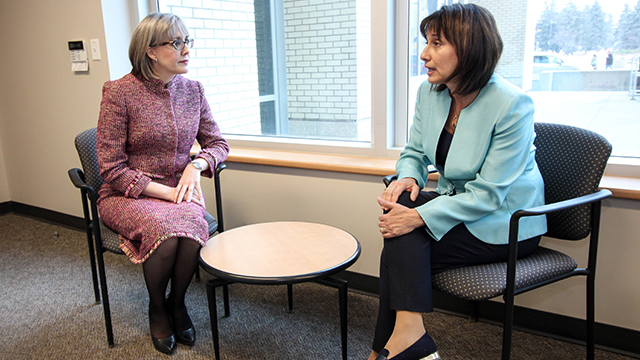
Tracy Hillier (left) and Helly Goez
The human body is incredibly complex, but according to Tracey Hillier, that's the easy part of teaching medicine. "Treatments and diagnoses may change," she says, "but you're not going to be a good physician able to relate to patients as people if you don't know who they are. Good communication means so much."
This is the premise of the changes Hillier has introduced since becoming assistant dean of curriculum for the University of Alberta's medical school. Hillier, alongside newly-appointed assistant dean of diversity Helly Goez, are two of the six Equity, Diversity, and Inclusion Award recipients recognized on March 16 at Lister Hall. The awards ceremony coincided with the U of A's Equity, Diversity, and Inclusion week, a campus-wide event geared towards increasing tolerance and understanding of human differences in the university community.
Raised in rural Newfoundland, Hillier sees authentic personal connection as the key to training better doctors. This means breaking down social barriers and challenging misconceptions in order to increase students' understanding of patients on a personal level. "It gives them a chance to connect with them as a person, not as a physician," she explains.
Hillier has introduced three big changes to the U of A's undergraduate medical education program: a patient immersion experience to the four-year physicianship course; a community service component where students provide vital services to inner city organizations in Edmonton; and a revised admissions process to reduce barriers to entering medical school for students from a variety of cultural and socioeconomic backgrounds.
There are now more than 30 new modules on social accountability and diversity that had direct input from medical students. "The students are my greatest resource," Hillier says. "They brought LGBTQ health to my attention as one of the gaps, so we were able to start addressing that."

These new initiatives have begun to bridge gaps across disciplines in the Edmonton health sciences community, and within departments of the Faculty of Medicine & Dentistry. There are now more than 20 community agencies in Edmonton that students can work with and learn about the challenges of homelessness, addictions and abuse, and this number is growing.
These modules are unique to the U of A, but Goez hopes to see the trend spread to other schools. "Direct communication is still a foundational resource in medicine," she says. "While technology allows us to achieve a lot, interpersonal communication cannot be brushed off or deleted. When you have eye contact, and the distance of a handshake, you have the power to affect a life in a very real way."
